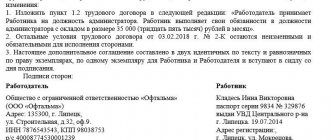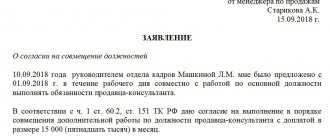What is a fixed-term employment contract?
The hiring of new employees is confirmed by the execution of employment contracts, which reflect the procedure and conditions of work, the rights and obligations of existing parties, as well as the duration of the employment relationship.
More detailed information about the procedure for registering contractual relations can be found in the material “Unified Form No. TD - 1 - Employment Contract”.
In this case, it is possible to conclude both open-ended employment contracts and contracts with a limited period of validity. The duration of the latter cannot exceed 5 years (Article 58 of the Labor Code of the Russian Federation). If a longer period is prescribed, then such an agreement becomes indefinite.
In accordance with the provisions of Art. 59 of the Labor Code of the Russian Federation, a fixed-term employment contract is drawn up on the basis of the following conditions:
- If you plan to hire a new employee whose responsibilities include performing the functions of temporarily absent employees.
- If it is necessary to perform seasonal or temporary (no more than 2 months) work.
- To perform specific types of work and services not related to the daily activities of an economic entity.
- To perform labor functions, the end date of which is determined by a specific date.
- When sending an employee abroad.
- If the nature of the work is related to studies, internships.
- For temporary employment of persons undergoing alternative civil service, or citizens sent to temporary work by employment centers.
- In other situations permitted by law.
In addition, fixed-term employment contracts can be concluded with paralegals and prosecutorial employees, as well as with persons in the civil service.
Employers also have the right to conclude employment contracts with a limited period of validity with the agreement of the interested parties (Article 59 of the Labor Code of the Russian Federation). These include small enterprises whose number of employees does not exceed 35 people. Also, contracts of this kind can be drawn up with:
- citizens who have reached retirement age, as well as those who, for medical reasons, are allowed only temporary employment;
- persons working in the Far North;
- employees whose activities are related to the prevention of natural disasters and other emergency situations;
- workers of culture and art;
- representatives of the management apparatus - managers, chief accountants;
- ship crew members;
- employees performing their duties part-time;
- full-time students.
Illegal establishment of the validity period of an employment contract, confirmed by the judicial authorities, transfers it to the category of indefinite (Article 58 of the Labor Code of the Russian Federation). The conclusion of fixed-term employment contracts that limit the rights of employees may be considered illegal. Thus, if dismissal is due to the liquidation of an enterprise or staff reduction, severance pay in the amount of two average monthly salaries is not due to employees who have entered into fixed-term employment contracts lasting up to two months.
For more information about severance pay and its taxation, see this resource.
Rules for drawing up a notification
Notice or notice of upcoming dismissal is drawn up no later than 3 days before the end of the employment contract.
This is also important to know:
Termination of an employment contract at the initiative of the employer, Article 81 of the Labor Code of the Russian Federation
Free legal consultation We will answer your question in 5 minutes!
Ask a Question
The text of the notification must contain:
Free legal consultation
We will answer your question in 5 minutes!
Ask a Question
- name of the organization, i.e. the document is drawn up on company letterhead or a corner stamp is used;
- the full name of the employee, his position and the name of the structural unit are indicated, all listed data must coincide with the order for admission or the last order for the transfer of the employee;
- the title of the document is compiled arbitrarily, as long as it reflects its content;
- since the document is an address to a citizen, it is customary to use the polite form “Dear First Name and Patronymic”;
- The text begins with the words “notify” or “warn”;
- The article of the law must be indicated as the basis for dismissal. 77 of the Labor Code of the Russian Federation (clause 2 of part 1);
- details of the contract for urgent performance of duties are provided, indicating its date and number;
- the document is signed by the head of the organization or the person replacing him, i.e. the one who has the right to sign orders, enter into and terminate contracts;
- the date of the notification is set;
- Below is the entry “I have read the notification”, under which the person familiarized with it must sign with a transcript and the date of familiarization.
A notice of dismissal under a fixed-term employment contract is registered in the order book, filed and stored, like other personnel documents, for 75 years.
It is enough to make one copy of the notice, but in most cases they make two copies or take a photocopy to give to the person being dismissed.
If it is impossible to hand it over in person, then the notice is sent by registered mail. To confirm the fact of delivery use:
- content inventory;
- notification of delivery.
Failure to comply with the basic rules for filling out the notice, for example, mismatch of dates, lack of signature on familiarization, may be considered by the court as a fact of illegal dismissal. The presence of a notification equates the action to an initiative of the administration, i.e. An application from the employee is not required.
Conditions for applying a fixed-term employment contract
Employment contracts with a limited duration are mainly concluded in cases where the type of work performed is temporary. In other situations, agreement of both parties is required.
If fixed-term contracts are periodically concluded with the same employee, the employer must be ready to provide reasoned explanations for the need to determine the terms. Otherwise, when considering conflict situations, such agreements may be recognized as unlimited by the judicial authorities.
If, after the expiration of the concluded employment contract, neither party has expressed a desire to terminate the employment relationship, the contract is recognized as unlimited. In this case, there is no need to make additional entries in the work book. However, the changes will need to be recorded in an additional agreement (letter of Rostrud “On the term of the employment contract” dated November 20, 2006 No. 1904-6-1). The extension of the term of the employment contract is also confirmed by the order.
Recommendations from ConsultantPlus experts will help you correctly arrange the extension of your fixed-term employment. If you don't have legal access, a full access trial is available for free.
Considering the fact that the expiration date of employment contracts does not imply their completion, employers are recommended to keep records of these documents themselves. Otherwise, employees will have to be dismissed on a general basis at the end of the completion period.
For additional information on the procedure for dismissal in certain situations, see the material “Procedure for dismissal due to liquidation of an organization.”
Automatic transformation of STD to BTC
The most important rule for an employer to remember when working with temporary employees is:
If the expiration date of a fixed-term employment contract has arrived, but neither of the parties, neither the employee nor the employer, has expressed a desire to terminate the employment relationship, the fixed-term contract by law becomes indefinite.
For example, if an employer accidentally forgot that his contract with Mr. Petrov expires on February 1, and the latter continues to do his job, then he automatically becomes a permanent employee. Then the employer will be able to dismiss him subsequently only on a general basis, having lost the opportunity to use the reason “expiration of the TD”.
If the nature of the employee’s work allows him to legally conclude an open-ended contract and both parties want to continue to cooperate, then it is enough for them not to do anything until the expiration of the contract. Then the parties enter into an addendum. agreement to the employment contract, and this will be the end of the documentation.
If the employer is legally unable or unwilling to continue his employment relationship with the employee for various reasons, then he needs to take specific actions in relation to the latter. Which? Let's look at it in the next paragraph.
Dismissal under a fixed-term employment contract
The process of terminating the employment relationship with employees who work on fixed-term contracts is slightly different from the standard dismissal procedure.
The reason for dismissal under a fixed-term employment contract may be the end of its validity period. But in this case, it is important not to miss the deadlines. The basis is clause 2 of Art. 77 of the Labor Code of the Russian Federation, which applies in cases where the parties have decided to terminate further labor relations.
Dismissal must be preceded by a written warning from management issued to the employee at least 3 days in advance. The fact that the dismissed person is familiar with the notice sent to him must be recorded. The only exception is the termination of the contract on previously accepted conditions, under which the duties of an employee absent for any reason were temporarily performed (Article 79 of the Labor Code of the Russian Federation).
The absence of notice of dismissal does not allow dismissing an employee due to the expiration of the employment contract. In such cases, the employment relationship can be terminated only on other conditions provided for by law.
Drawing up a notice of termination of an employment contract is allowed in any form. It should reflect the date and reason for dismissal. If the employee refuses to familiarize himself with the notice, a corresponding act is issued.
Termination of employment under a fixed-term employment contract is permitted in the following cases:
- If the contract is drawn up for the purpose of performing certain types of work, termination occurs upon completion. In this case, an act of acceptance and transfer or performance of work is drawn up. The end of the contract term is the next day after the act is drawn up.
- If the contract implied the fulfillment of the duties of a temporarily absent employee, then it terminates when the employee returns to the workplace.
- A fixed-term contract can also be concluded for a period of seasonal work. It ends after the end of the designated period. Lists of seasonal work and their terms are established by the Government of the Russian Federation.
See also “Termination of a fixed-term employment contract during sick leave.”
After the termination of the employment relationship, the employee receives a work book, payroll and related documents.
For more detailed information about the documents issued upon dismissal, see the material “Certificate of wages - sample and form in 2022.”
If an employee decides to leave the workplace after the end of the contract, the employer does not have the right to retain him.
Upon dismissal, the employee is guaranteed all due monetary payments: payment for the period of work, compensation for unused vacation. If a fixed-term contract was drawn up for a period of up to 2 months, then compensation for vacation is calculated at the rate of 2 days for 1 month worked (Article 291 of the Labor Code of the Russian Federation). The grounds for termination of the employment relationship do not affect the amount of compensation paid. The terms of the contract may provide for other payments, such as severance pay, the amounts of which are reflected in local documents.
Under some circumstances, the termination of fixed-term contracts occurs earlier than the established period, including on the basis of the provisions of Art. 77 of the Labor Code of the Russian Federation, by mutual agreement of the parties, at the initiative of the employer and other circumstances beyond the control of the parties.
Dismissal under a fixed-term employment contract caused by the employee’s initiative must be accompanied by a written notification from management 3 calendar days before the expected date of termination of the employment relationship.
Main reasons for termination of STD
According to the Labor Code, the employment of a new employee by default is carried out on an indefinite basis. However, there are exceptions: the law lists in detail cases where the nature and conditions of work either prescribe or allow the employer to enter into an agreement indicating the deadline for its completion.
Then the contract specifies either a specific date when its validity expires, or indicates a specific event after which the employee’s services will no longer be needed.
In any case, as the agreed end date of a fixed-term contract approaches, the employer begins to think: is it necessary to terminate such a contract and how?
By law, any dismissal must have a reason, which must be indicated in the documents. STD has only one particular reason for dismissal, which is not characteristic of BTC - namely, the expiration of the employment contract. All other grounds are common to both fixed-term and open-ended employment contracts.
Let us consider all these reasons in turn, which we will conditionally divide into five categories:
- Expiration of the STD;
- On agreement of the parties;
- At the initiative of the employee;
- At the initiative of the employer;
- Due to independent circumstances.
Expiration of the STD
- Return to work of the main employee. Then the deputy is forced to leave. For example, a young mother returning from maternity leave or the recovery of a key employee;
- The end of work, temporary or seasonal, for which the employee was hired. For example, the end of the harvest or the completion of equipment installation;
On agreement of the parties
Dismissal by agreement of the parties is considered the most “peaceful” reason. In theory, this means that both the employer and the employee have decided not to continue the employment relationship and are terminating it by mutual agreement.
At the initiative of the employee
Dismissal at one's own request may have the following reasons:
- Serious illness of the employee himself or the onset of disability, in which work becomes impossible;
- Serious illness of one of the employee’s family members and, as a result, the need to care for the sick;
- Violation by the employer of the Labor Code, the terms of the contract or his duties. For example, if in the contract the employer agreed to organize hot meals for the harvesters and did not fulfill the obligation;
- Changing the employee’s place of residence or moving with a spouse;
- Transfer of an employee to another employer or assumption of an elective position;
- Refusal of the employee to continue the employment relationship due to the reorganization of the company, change of owner or change in the type of enterprise;
- Refusal of an employee to follow the employer if he moves to another area.
The employee is obliged to notify the administration of his intention two weeks before actually leaving work. During this period, the employee can withdraw his application in writing if he has changed his mind and another person has not yet been hired in his place. After this period, the employee has the right not to go to work.
If a fixed-term contract was concluded for a period of up to two months or for seasonal work, the employer must be notified three days before dismissal. However, by mutual agreement, “working off” may not be required at all or may be reduced.
In case of unlawful resistance on the part of the employer - failure to admit his guilt or a valid reason - the employee can file a complaint with the court or the Labor Dispute Commission.
At the initiative of the employer
An employer may terminate relations with an employee early on the following grounds:
- Liquidation of the organization;
- Reducing the number of employees;
- Change of owner (applies to the manager and his deputy, as well as the chief accountant);
- The employee systematically evaded the performance of his official duties or performed them improperly;
- The employee violated labor discipline;
- It turned out that the employee presented false documents during employment or his qualifications did not meet the required level (determined during certification);
- Causing significant harm to the organization;
- Committing theft or disclosing trade secrets.
If an employee is on sick leave or on vacation, during this period he cannot be dismissed at the initiative of the employer. The exception is the liquidation of an organization.
Dismissal due to independent circumstances
In some cases, dismissal is forced, although neither the employee nor the employer wanted it.
This occurs under the following circumstances:
- Conscription of an employee to military or alternative civilian service;
- Transfer of a person to a place of imprisonment in connection with a court verdict;
- Reinstatement of an employee to his previous position in connection with an official decision of the labor inspectorate or court;
- Death of an employee or the occurrence of emergency circumstances (war, earthquake, major accident, epidemic).
Results
Termination of a fixed-term employment contract must be carried out in accordance with all the rules enshrined in the Labor Code of the Russian Federation, in compliance with the established deadlines.
Otherwise, if conflict situations arise between the parties, termination of the contract will have to be carried out on a general basis, involving longer service or, possibly, a higher level of payments upon dismissal. You can find more complete information on the topic in ConsultantPlus. Free trial access to the system for 2 days.
Rules for drawing up an order and filling out a work book
The Resolution of the State Statistics Committee of the Russian Federation of 2004 approved the main samples of administrative documents, including the dismissal order in the T-8 form.
This is also important to know:
Dismissal of the CEO of an LLC at his own request or on the initiative of the founder
The following details are required in the order:
- Date of preparation;
- registration number;
- document's name;
- Full name and position of the dismissed employee;
- information about the employment contract that is terminated by this order;
- grounds for dismissal (expiration of the temporary contract);
- article from the Labor Code of the Russian Federation - art. 77 of the Labor Code of the Russian Federation (clause 2 of part 1);
- date of termination of the employment relationship;
- manager's signature;
- signature of the familiarized person with transcript and date;
- in case of refusal, a note is made about this, which is signed by at least two employees;
- The previously drawn up and served employee notification is indicated as an annex to the order.
One copy of the order is given to the employee, the second is filed in the file according to the nomenclature.
Dismissal of a temporary employee for other reasons
At your own request
An employee working under a fixed-term contract can leave at any time of his own free will. In this case, the usual dismissal rules apply, i.e. at least 14 days must pass from the date of filing the application to the actual dismissal (except for cases of dismissal without service provided for by law).
The exceptions are persons whose contract period does not exceed 2 months or seasonal employees. For them, the working period is 3 days.
At the initiative of the employer
Before the end of the contract, an employee may be dismissed at the initiative of the employer. All possible cases are specified in the Labor Code. Main reasons:
- liquidation or reorganization of an enterprise;
- staff reduction;
- violation of labor discipline by an employee (absenteeism, drunkenness in the workplace, failure to fulfill official duties);
- damage to the enterprise (theft, transfer of commercial information to third parties, damage to property);
- provided false documents about qualifications, education, work experience.
All actions of the employer must comply with the general rules of dismissal provided for by the Labor Code.
Dismissal of persons on sick leave and pregnant women
An ill employee is not entitled to an extension of the contract period during illness. The administration may notify him in writing or in person. In the same way, the dismissal order and work book are handed over.
This is also important to know:
Dismissal - entry in the work book, sample 2022
The exception is pregnant women. If a temporary employee presents a certificate of pregnancy, then the term of her contract is extended until the end date of the sick leave for pregnancy and childbirth. During the period of such forced extension of the contract, it is necessary to present a new certificate from the hospital after three months confirming the fact of pregnancy.
If a pregnant woman was hired during the absence of the main employee, she may be fired on the eve of this person's departure. But if there is a vacancy at the enterprise, the administration is obliged to offer her one of the available positions. Upon agreement, a new temporary or permanent contract is drawn up. If there are no such vacant positions or they do not suit the pregnant woman, then they formalize her dismissal at the end of the fixed-term employment contract.
Does an employee have to work off?
If a fixed-term employment contract ends prematurely, the same rules apply as with a permanent employment contract. This means that the parties must comply with notice periods for dismissal. This is not required only in the following cases:
- When an employee is fired for violating discipline or the law. No work needed here.
- When dismissal occurs against the will of the parties (for example, when an employee is drafted into the army).
- When the parties agreed differently. With the consent of the employer, the employment contract at the request of the employee can be terminated immediately, and the employee, warned of the upcoming dismissal, can agree to early termination.
- When, according to the law, dismissal without service is allowed. For example, if the dismissal is caused by the inability to continue the employment relationship for objective reasons, the employee may resign within the period specified by him.
Calculation of payments due to an employee
An employee who has entered into a fixed-term contract with an enterprise is entitled to compensation for unused paid vacations. The calculation of the amount of payments is made in accordance with the norms of the Labor Code.
This is also important to know:
Unlawful dismissal: consequences for the employer
Depending on the terms specified in the contract, the amount of payments varies:
1. An employee registered for a period of up to 2 months has the opportunity to receive monetary compensation for unused vacation pay. But such a privilege is available only to those employees who have worked at the enterprise for more than 15 days. In this case, the sum of the months worked is multiplied by 2, and the resulting figure is multiplied by the average daily earnings.
If in one of the working months the employee worked for less than 2 weeks, then this time is not taken into account in the calculation, but if on the contrary, then the period worked is counted as a whole month.
An employee registered for a period of up to 2 months has the opportunity to receive monetary compensation for unused vacation pay.2. For an employee who has registered with an enterprise for a period of 2 to 11 months, the amount of due payments is calculated in the same way as in the previous paragraph. However, the amount of compensation will vary.
3. For an employee employed for a period of more than 11 months, compensation is calculated with a coefficient of 2.33. When calculating, you need to subtract the vacation days used.
The entrepreneur is obliged to pay monetary compensation on the day the employee is dismissed, because It is illegal to detain her.
After terminating a contract with an employee, you are not required to immediately notify the Pension Fund about the transaction, since you report on personnel every reporting period. But if you wish, you can send a notice of termination of the contract with an employee in free form. Temporary employment relationships are regulated by law. When concluding a fixed-term employment contract with an employee, an entrepreneur must know in advance all the legal aspects of his dismissal at the end of the contract.
Documentation
Dismissal at the end of a fixed-term employment contract involves drawing up and filling out the following documents:
- Employee statement. If the dismissal occurs at their own request, the employee writes a statement two weeks in advance, indicating the reason for his decision. Usually, an article of the Labor Code of the Russian Federation and a paragraph of this article are prescribed.
- Notification to the employer (if the manager takes the initiative in dismissal). The document must be drawn up in 2 copies, registered in the personnel department and contain the reason for dismissal, a request for confirmation of reading this notice must be written and the signature of the dismissed employee must be written.
- Order of dismissal. The document must be prepared on the day of dismissal of the employee in several copies, one of which remains with the employer with the employee’s signature confirming its familiarization. If for some reason the employee was not familiar with the order, an appropriate note should be made about this.
- The completed work book is handed over to you.
This is also important to know:
Certificates upon dismissal of an employee in 2022: what certificates does the employee receive?
Correct execution of all documents will allow the employer to avoid possible future legal disputes or proceedings with the labor dispute commission.
Discussion of the terms of the agreement
If the employee or employer has agreed to the dismissal proposal by agreement of the parties, then the most important stage begins - discussing all the details. Such conditions should not be imposed by one party. That is, both the employee and the employer must come to a common agreement based on the results of the negotiations, since termination of the contract is interesting to both of them.
Let’s remember the situation with Ivan and “LLC” Rose. Ivan, as an employee, may be interested in early termination by agreement of the parties, as he wants to receive good compensation upon dismissal. And Rosa LLC, as an employer, is interested in “getting rid of” Ivan, who is not interested in work, and quickly finding a new employee who will be happy to complete tasks.
To avoid possible legal disputes, the employer should not pressure or force the employee to sign an agreement on its terms. Otherwise, such an agreement may be declared invalid and the dismissal may be illegal.
Discussion of terms does not always look like negotiations. Often, an employee reads a pre-prepared text of an agreement and, before signing it, makes a decision: agree completely with its terms, make any changes to it, or completely refuse the proposed conditions.
Let's consider the most important questions that may arise during the discussion stage:
- What terms are the parties discussing? The most important thing is to reach agreement on the date of termination of the contract, since labor legislation does not establish “working periods”, as, for example, when dismissal at the initiative of the employee. Since the Labor Code of the Russian Federation does not establish special compensation payments for dismissal by agreement of the parties, the employee and the employer can also discuss the amount of such payments.
It should be noted that the parties have the right to determine any conditions of dismissal, since the law does not limit them to this (for example, an employee, before terminating a fixed-term contract, can ask the employer for leave, etc.). - Who draws up the agreement? As a general rule, the text of the agreement is developed either by a personnel officer (HR service specialist), or a lawyer, or another representative of the employer who knows labor legislation. After this, the agreement is submitted to the employer and employee for review. However, the employee may insist that he also participate in developing the text of the agreement.
How to draw up a document (with a sample)?
Labor legislation does not contain a generally accepted example of an agreement, so in each specific case such a document may look different. However, in practice it is customary to compose it as follows (see example):
Agreement on termination of a fixed-term employment contract (sample)
A set of elements that are recommended to be specified when compiling this document:
- Agreement header, which includes:
- Information about the parties to the labor relationship - the full name of the employer and full name of the employee.
- The date the agreement was signed, as well as its number, which is indicated for internal recording of the employer’s documents.
- Information about the fixed-term employment contract (number and date of conclusion, you can also indicate the expiration date of the contract).
- The main part of the document, which consists of the terms of the agreement reached. As a general rule, these conditions include:
- Date of the employee’s last working day (date of termination of the fixed-term employment contract). Any date can be set, that is, the employee and the employer can decide to terminate a fixed-term employment contract either on the day the agreement is signed or several months after its signing.
- Compensation payments and additional remuneration that are due to an employee upon dismissal. The employer, in agreement with the employee, can determine any amount of such payments. To avoid disputes, it is best that the exact amount of compensation be specified in the agreement. Since the employer does not always fulfill its obligations in good faith, the employee is recommended to insist that the date of payment be clearly stated, as well as penalties for late payment.
- Other obligations on the part of the employer (for example, providing the employee with leave before terminating the contract, etc.).
- Responsibilities that an employee must fulfill before leaving (for example, putting the workplace in order, finishing a project, transferring materials to a colleague, etc.).
- The parties have no claims against each other.
- Signatures of the parties. When signing an agreement, the employee should pay attention to the authority of the person signing the document on the employer’s part.
Important! The document is drawn up in two copies.
Recommended reading:
How to quit your job remotely?
How to cancel a dismissal and withdraw an application?
Is it a working day or not?
The procedure for terminating a contract with an employee before the expiration of the term
How to terminate a TD early? In order to terminate a fixed-term employment contract before its expiration, the parties must proceed as follows.
You can find out how to terminate a fixed-term employment contract upon expiration here, and from this article you will learn how to correctly formalize dismissal by transfer.
Submitting an application or sending a notification
If the contract is terminated early at the initiative of the employee, he must submit an application addressed to the head of the enterprise . In it, the employee indicates his name and position, and also expresses his desire to resign.
In addition, the application must indicate the date on which it was submitted. The point is that Art. 80 of the Labor Code of the Russian Federation provides that when resigning at will, an employee must submit an application at least two weeks before the desired date of termination of the contract.
This time is needed for the employer to find a replacement for the retiring employee. If desired, the head of the organization can fire the employee earlier, but is not obliged to do so.
Important. In some cases, the law makes it possible to resign immediately. This applies to situations where, for objective reasons, the employee cannot continue to work. In addition, if a “conscript” was hired for seasonal work, the notice period for him, according to Art. 296 of the Labor Code of the Russian Federation, only three days.
As for cases when an employee is fired by an employer, the employee must be warned in advance about the upcoming termination of the employment relationship . This document is drawn up by the employer in free written form, and it must indicate the following:
- The name of the employee and his position, as well as the structural unit in which he works.
- The grounds on which, in accordance with the Labor Code of the Russian Federation, termination of labor relations occurs.
- Date of upcoming dismissal.
The employee gets acquainted with the notice of termination of TD against signature , and if necessary, he is given a copy of the document.
How many days in advance is notice of termination of TD given? The deadline for filing depends on the reasons for which the employee is dismissed. The Labor Code of the Russian Federation provides for the following periods before the date of dismissal, during which the employee must be notified:
- Unsuccessful results of the entrance test for employment – 3 days.
- The company is being liquidated, or there is a reduction in headcount or staff - 2 months. If the contract was concluded for less than 2 months, then the period is 3 days.
- Bankruptcy proceedings have begun under the Federal Law “On Insolvency (Bankruptcy)” - 1 month from the date of introduction.
Important. When dismissal for violation of discipline or other guilty actions of an employee, notification is not provided.
Order
The dismissal itself is carried out using an order issued by the employer. The order is drawn up either on form T-8, or using a form developed and approved by the enterprise itself. The order must indicate:
- The employee's name, position, and department.
- Grounds for dismissal (application, notice).
- The norm on the basis of which an employee is dismissed (the corresponding article of the Labor Code of the Russian Federation).
- Date of dismissal.
The employee gets acquainted with the order against signature, the document itself is registered (as well as the notification) in the personnel document register .
Filling out a work book and personal card
One of the most important issues in the dismissal procedure for any reason is the correct execution of personnel documents (read about what documents an employee needs to prepare upon dismissal and how to document this process correctly). The most important of them are the work book and personal card.
The rules for maintaining a work book were approved by Decree of the Government of the Russian Federation No. 225 of 2003. They stipulate that the last entry relating to the dismissal of an employee must necessarily include the following:
- The serial number of the entry according to the continuous numbering used in the work book.
- The date the entry was made (also the date of dismissal).
- Grounds for dismissal.
- The legal norm that the employer followed. The entry must indicate both the part and the paragraph of the article of the Labor Code of the Russian Federation, and they must be indicated without abbreviations or abbreviations.
The following photo shows an example of an entry in a work book about the termination of a fixed-term employment contract:
The entry is certified by the signature of the person responsible for maintaining work books and the seal of the organization. As for the personal card issued in the T-2 form, an entry is made in section XI. The content of the entry is the same as that made in the work book.
Important. All three main documents - order, work book and personal card - must use the same wording.
Calculation and issuance of documents
For any dismissal (including early dismissal), full payment to the resigning employee must be made on the last day of his work . During the same period, he must be issued documents related to his work activity. The only exception is the situation when the employee himself does not come to collect documents and money. In this case, the employer notifies the former employee in writing of the need to collect the due amount - and in the future no longer bears responsibility for the delay in delivery.
As for the documents issued upon early dismissal, the main one is the work book. However, if necessary, the employee can receive other documents containing information about his work. In particular, he can receive a 2-NDFL certificate, information about transfers to the pension fund, etc.
Who is the initiator?
Labor legislation provides that dismissal can be initiated by both the employee and the employer. In order to begin the process of terminating a fixed-term employment contract, one of the parties should make a proposal to terminate the employment relationship.
Such an offer may be made either in writing or orally. That is, one of the parties can simply come to the other party in order to inform about the termination of the fixed-term employment contract.
However, the oral form of the proposal assumes that the parties will not have confirmation of the voluntariness of initiating dismissal.
Therefore, it is recommended to draw up a written document - a proposal (application) to terminate a fixed-term employment contract. Such a document is either given to one of the parties to the labor relationship, or sent through convenient communication channels (mail, e-mail, etc.).
The form of the offer is not enshrined in labor legislation, so the main thing is that it contains the intention to terminate a fixed-term employment contract (see Examples).
Sample proposal to terminate a fixed-term employment contract by agreement of the parties (initiator - employee):
Proposal to terminate a fixed-term employment contract by agreement of the parties (initiator - employee)
If the initiator is an employer:
Proposal to terminate a fixed-term employment contract by agreement of the parties (initiator - employer)
+
Important!
The proposal may or may not specify the exact date of termination of the employment relationship. Since the employee is the weak party in labor relations, it is important for him to understand that if he writes down the date of dismissal in the offer and does not indicate any further conditions, and the employer agrees to this, then he will not be able to refuse further dismissal (clause 20 of the PPVS No. 2 dated March 17, 2004: cancellation of the agreement is possible only by agreement of the parties).
Therefore, when drawing up an application, it is recommended that the employee either indicate all the conditions of dismissal (compensation payments, date of dismissal, etc.), or indicate only his intention to terminate the fixed-term employment contract.
In judicial practice, the following position has been developed: in the absence of a separate document in the form of an agreement, dismissal by agreement of the parties is recognized as legal if the employee’s application indicates a specific date for termination of the contract, and there is also an order for dismissal (see Determination of the Moscow City Court dated August 24, 2010 in the case N 33-26190).
Having received an offer to terminate the employment relationship, the employer or employee can either agree to the further procedure for terminating the contract (by signing a document) or refuse. By signing the application, the other party can offer their terms of the agreement, that is, agree to terminate the fixed-term employment contract subject to conditions.
Example.
Let’s imagine that Ivan works at Rosa LLC under a fixed-term employment contract. The employer sees that Ivan is not particularly interested in the work process, so he sends him a proposal to terminate the contract.
After thinking for several days, Ivan comes to the conclusion that he does not want to quit. In this situation, the employer will not be able to force Ivan to resign. If Ivan agrees and signs the proposal, then the parties move on to the next stage.
Recommended reading:
The procedure for dismissing an employee upon expiration of the employment contract
Procedure for terminating a fixed-term employment contract at the initiative of the employee
Termination of a fixed-term employment contract at the initiative of the employer






